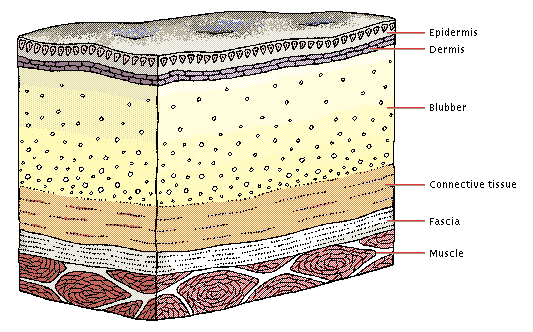Thermoregulation
Whales are endothermic homeotherms, meaning they regulate their internal temperature to keep it constant regardless of the environmental temperature. This becomes quite challenging when you need to maintain 37 C and are surrounded by water as cold as -1.9 C. Water is a much better conductor than air and can remove heat about 25 times faster. Whales have adapted a complex vascular system and a thick layer of adipose tissue, or blubber, to meet these challenges.
Blubber does a great job of insulating the whale’s core, it can also act as a food reserve and helps to keep them buoyant in the water. Depending on the species and time of year, blubber can make up about 15%-45% of the whale's total body mass. Bowhead whales have the thickest layer of blubber, ranging from 17-20 inches, this helps them be able to call the Arctic Ocean home. The blubber is made more effective thanks to the low surface area to volume ratio of the whale's body. The smaller surface area means the whale loses heat at a slower rate since less of its body is in contact with the environment. The outer layer of skin stays at a temperature close to that of the environment in order to reduce the amount of heat that is lost due to conduction. Furthermore, both sexes have genitals that are concealed within the body to easily keep the temperature constant. (Berry 2020)



The flippers, dorsal fin, and fluke are not well insulated, lacking thick layers of blubber, so instead they utilize countercurrent heat exchange. The veins and arteries in the vascular system are very close together so that heat can easily be exchanged between them. The blood leaving the heart is warm and gets pumped throughout the body, when it reaches the extremities it comes in close contact with blood that is being circulated back to the heart, warming it in the process. This adaptation not only helps reduce the amount of heat lost, it also helps protect the heart from shock that could occur from receiving blood that is too cold. Occasionally whales also need to lose heat when their activity levels raise their internal temperature too much. The flippers, dorsal fin, and fluke are known as thermal windows, due to their low insulation, it’s a great place to be able to lose heat when needed. (Scholander, et al 1995) Baleen whales spend a lot of time with their mouths wide open feeding in cold water. To help prevent heat loss in this area they also utilize counter current heat exchange in the palette of their mouth, which is the pink area on the roof of their mouth that’s connected to the upper jaw. Both toothed and baleen whales have tongues that also use this strategy. (Heyning 2001)